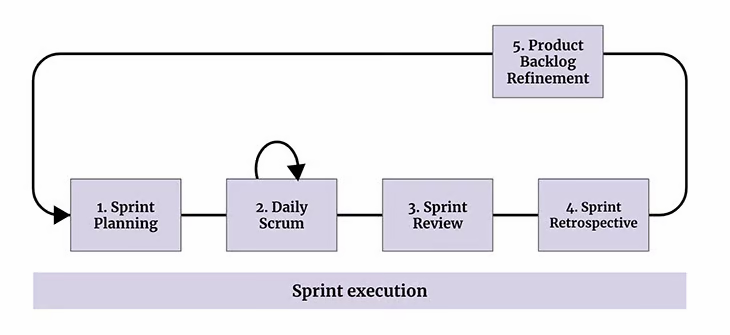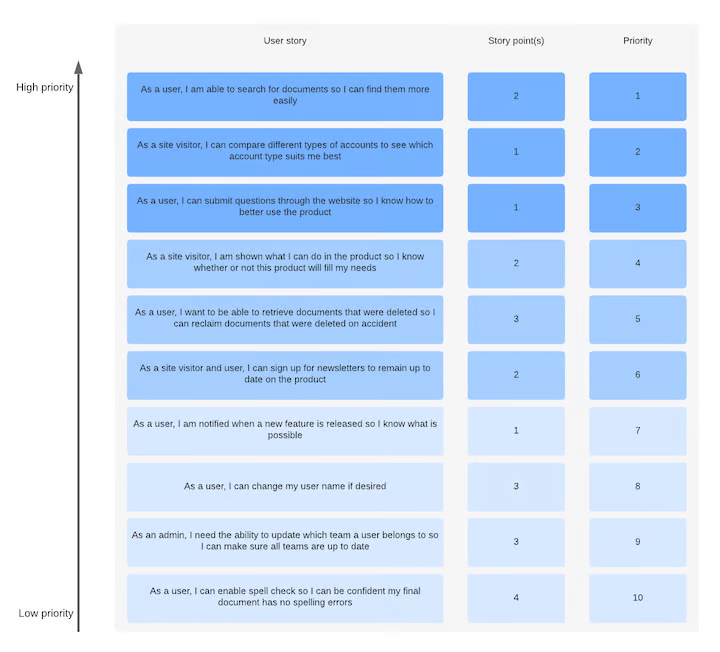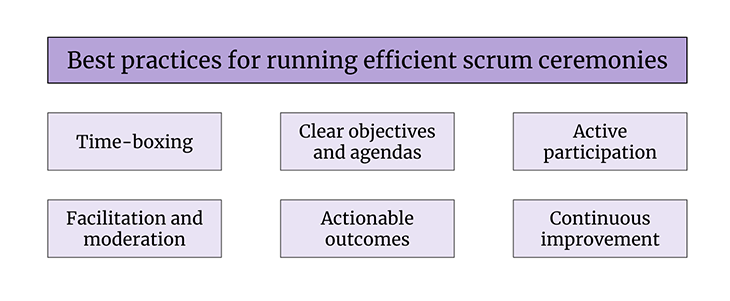Editor’s note: This article was last reviewed and updated on 3 October 2024 to provide a high-level summary of the article’s focus, include more details about who leads scrum ceremonies and what the purpose and benefits of these meetings are, and more.

Scrum ceremonies are a series of structured meetings led by scrum masters that provide a foundation for effective communication, collaboration, and decision-making among team members. “Ceremonies” is essentially just a fancy name for events or meetings.
There are five scrum ceremonies, and they usually take place in this order:
The duration of each scrum ceremony may vary depending on the length of the sprint. These scrum ceremonies are designed to promote transparency and accountability. They help teams:
The nature of scrum is to drive continuous improvement, and by executing projects using the five scrum ceremonies, the team is constantly able to iterate and improve as the project moves along. Ultimately, this leads to higher-quality products and (ideally) increased customer satisfaction.
In this article, we’ll provide an overview of these five scrum ceremonies and their importance.
A main characteristic of a successful product management organization is the ability to stay nimble and adaptive. Though many methodologies and practices enable this, the scrum framework is specifically built around maintaining and encouraging this flexibility.
When the originators of scrum wrote The Scrum Guide, they specified various practices that need to be followed to successfully implement scrum and agile into an organization. One of these components and practices is the five scrum ceremonies: sprint planning, daily scrum, sprint review, sprint retrospective, and product backlog refinement.
These five ceremonies are all different meetings that involve various members of the scrum team. They take place at different times throughout the course of the sprint:

Now that you have a general overview, let’s go over each of them in more detail!
Sprint planning is pretty much what it sounds like — the team gathers to kick off a new sprint, which is a fixed period dedicated to completing a set of tasks. The process begins with establishing the sprint goal — a high-level objective that helps the team understand the desired outcome of the sprint.
Next, the team selects backlog items to be developed in the sprint. The product backlog is a prioritized list of features, enhancements, bug fixes, and other tasks that the team needs to work on. One of the product owner’s jobs is to maintain this list and ensure that the items are clear, valuable, and ordered by priority. The development team collaborates with the product owner to select the backlog items to include in the sprint:

Once the backlog items for the sprint are chosen, the development team breaks them down into smaller, manageable tasks called sprint backlog items. The sprint backlog is a subset of the product backlog; it focuses solely on the tasks to be accomplished during the current sprint.
All members of the scrum team (the scrum master, product owner, and development team) should be there in sprint planning. If the sprint is the traditional one-month timeframe, the sprint planning meeting is usually a full day in duration. If it’s less than a one-month sprint, the meeting is timeboxed proportionally — two hours of sprint planning for each week of the sprint.
The next scrum ceremony is the daily scrum. This is also called daily standup in some organizations.
The daily scrum happens every day for 15 minutes. During this meeting, each member of the development answers three questions:
Relatively simple, the daily scrum acts as an update meeting — it keeps everyone on the same page. The only required attendants of the daily scrum are the scrum master and the development team. Others may attend if they’d like, but it’s not necessary. The main and most important purpose of the daily scrum is to figure out if any blockers or impediments are preventing the development team from doing their work.
“Blocks” refers to technical or specific work-related issues preventing progress on a particular task. If there are any, developers can usually fix these blocks themselves. Examples of this include bugs in the code or problems with a tool.
“Impediments,” on the other hand, refers to anything that hinders the team’s progress or reduces its efficiency. This can be directly related to the work at hand or not, such as slow approval processes, faulty equipment, etc. Impediments need to be fixed by the scrum master since their job is to keep the team efficient and adhering to scrum.
The sprint review ceremony happens as the sprint comes to a close. This is the opportunity for the team to show off the completed work, gather feedback, and adjust their future plans. The review ceremony is time-boxed to four hours for a one-month sprint, though it is usually shorter for shorter sprints.
All relevant parties attend this meeting, even beyond the scrum team. Aside from the scrum master, product owner, and development team, other relevant stakeholders such as clients or users can join.
In essence, this scrum ceremony exists for two reasons: demonstration and feedback. Meeting attendees can ask questions and see the results of the team’s hard work. The product owner reviews the current state of the product backlog and takes into account any new insights, feedback, or changes in priorities from the meeting attendees.
Then, based on the feedback received, the product owner and the development team discuss any necessary changes to the product backlog and identify potential backlog items for the upcoming sprint. This discussion helps the team align their future plans with stakeholder expectations and ensures that they continue to deliver value in subsequent sprints.
You may have heard the word “retro” before to describe review or reflection meetings. It’s the same idea here — the team discusses what went well and what didn’t. Based on this feedback and reflection, the team figures out how to improve or modify the next sprint to improve efficiency.
The sprint retrospective really captures the essence of scrum in that it serves as a way to promote continuous learning and development.
The development team participates in the sprint retrospective and the scrum master facilitates the meeting. The idea is to transparently assess performance, identify areas for improvement, and create actionable plans for the upcoming sprint.
These actionable plans are items that can be implemented as soon as the next sprint. The team needs to collaborate on these, and the action items may include changes to the team’s processes, tools, or ways of working. The goal is to make measurable improvements that will positively impact the team’s performance and the product’s development.
The entire sprint retrospective is time-boxed to a max of three hours, but it can be less depending on the length of the sprint.
Many people tend to confuse the sprint review vs. the sprint retrospective, so here’s a summary of their key differences:
| Sprint review | Sprint retrospective |
|---|---|
| Scrum team and stakeholders attend | Only the scrum team attends |
| Goal is to present work to stakeholders and gather feedback | Goal is to improve efficiency for the next sprint session |
| Sprint reviews finish items from the product backlog | Sprint retrospectives create tasks to improve workflow |
| Discusses what the team is working on | Discusses how the team is working |
Lastly, we have product backlog refinement, aka backlog grooming. The purpose of this scrum ceremony is to clean and prioritize the backlog.
During this meeting, the product owner and some (or all) of the team members review the backlog items together.
There’s no time limit to this ceremony, but it’s recommended to only dedicate one hour per week to product backlog refinement. Some teams like to do this to help keep them organized and smooth out the sprint planning process for the next sprint (since product backlog refinement will basically roll over into the new planning meeting).
| Name | Duration | Members | Explanation |
|---|---|---|---|
| Sprint planning | Two hours for each week of the sprint | Scrum master, product owner, development team | During sprint planning, the team comes together to establish the sprint goal, select the backlog items to develop, and create a sprint backlog. This ceremony helps the team prioritize work, understand the requirements, and set achievable expectations for the sprint |
| Daily scrum | 15 minutes per day | Scrum master, development team | The daily stand-up is a short, daily meeting where the development team shares updates on their progress, plans for the day, and any blockers they’re facing. This ceremony keeps the team in the loop with one another |
| Sprint review | Four hours or less | Scrum master, product owner, development team, stakeholders | The sprint review takes place at the end of each sprint, providing an opportunity for the team to demonstrate the completed work to stakeholders and receive feedback. This ceremony encourages collaboration and ensures that the work aligns with stakeholder expectations. It also helps the team identify potential improvements |
| Sprint retrospective | 1–3 hours | Scrum master, development team | The sprint retrospective is a time for the team to reflect on the past sprint, discussing what went well, what could be improved, and any action items to address in the next sprint. This ceremony fosters continuous improvement and helps the team optimize their processes and performance |
| Product backlog refinement | One hour per week (recommended) | Product owner, development team, scrum master (optional) | Product backlog refinement, also known as backlog grooming, is an ongoing process where the product owner and development team review and prioritize the product backlog items. This ceremony ensures that the backlog remains up-to-date and well-organized, with clear, actionable items that are ready for the next sprint |
The order of scrum ceremonies is important for a smooth sprint and maximizing the benefits of the scrum framework. Each ceremony builds on the previous one and creates a logical sequence. This is the reason scrum can work so well — the team can plan, execute, review, and improve their work consistently.
The five scrum ceremonies are typically carried out in the following sequence:
Let’s dive deeper into each stage of this process and explore why the order of events is important in scrum.
First up is sprint planning. This ceremony sets the stage for the upcoming sprint by defining the sprint goal, selecting the most relevant backlog items, and creating a sprint backlog. Conducting this meeting at the beginning of the sprint helps the team to align their efforts, prioritize tasks, and establish clear expectations for the sprint.
Every day of the sprint, the daily scrum or stand-up acts as a checkpoint for the team to share progress, address any obstacles, and get on the same page.
At the end of the sprint, the team gathers for the sprint review to showcase their completed work and gather feedback. They also assess overall progress towards the project goals. This ceremony’s spot at the end of the sprint allows the team to get important feedback that can be incorporated into future plans.
After the sprint review, the team conducts the sprint retrospective to reflect on their performance. This is super important to identify areas for improvement and create actionable plans for the next sprint. Ultimately, the retrospective helps the team set up for a more efficient sprint next time.
Lastly, although optional, the product backlog refinement ceremony is a helpful practice that keeps the product backlog organized, prioritized, and accurate. Holding this meeting between sprints allows the product owner and team members to prepare for the next sprint planning meeting, ensuring that the product backlog remains aligned with project goals and stakeholder expectations.
Scrum ceremonies are only helpful if they’re run properly and with best practices in mind. Below are some ideas to help you run efficient scrum ceremonies:

Each ceremony should be time-boxed, aka limited to a specific time. This will help keep everyone on track to address the most important items in a timely manner. Nobody likes meetings that are unnecessarily long — participants can lose interest and become disengaged. This is why strictly adhering to these time constraints helps prioritize discussions and prevents meetings from becoming overly lengthy or unproductive.
Establishing clear objectives and agendas for each ceremony helps guide the conversation and ensures that all participants understand the purpose of the meeting. This clarity promotes focused discussions and enables the team to make the most of their time together.
Encourage all team members to actively participate in discussions, share their ideas, and voice any concerns. This open communication is important for creating and maintaining a collaborative environment.
Consider all perspectives — it’s important for team members to feel comfortable sharing their opinions, even if they may go against the grain. Nurturing psychological safety will create a trusting team environment and allow everyone to speak their mind.
The scrum master plays a crucial role in facilitating and moderating ceremonies, ensuring that the team stays on track and that discussions remain productive. The scrum master needs to remain neutral so they can guide the conversation and address any conflicts without bias.
Each ceremony should result in actionable outcomes, whether it’s a sprint backlog, identified improvements, or action items for the next sprint. To ensure that you’re creating actionable outcomes, they should be clear, measurable, and assigned to specific team members.
The nature of scrum and agile is continuous improvement. Embrace this agile principle by regularly evaluating the effectiveness of your scrum ceremonies and adjusting your approach as needed. Solicit feedback from the team and be open to experimenting with new techniques — don’t be resistant to change.
The five scrum ceremonies — sprint planning, daily scrum, sprint review, sprint retrospective, and product backlog refinement — are the heart of the scrum framework. They’re the oil that keeps the agile machine running smoothly and are essential for establishing a well-structured, iterative approach to product development.
By fully understanding and embracing the purpose of each ceremony, your team can effectively plan, execute, review, and continuously improve their work. So, don’t cut corners when it comes to scrum ceremonies. In the realm of agile, they are the key ingredients for unlocking your team’s full potential and delivering high-quality products.
Featured image source: IconScout

LogRocket identifies friction points in the user experience so you can make informed decisions about product and design changes that must happen to hit your goals.
With LogRocket, you can understand the scope of the issues affecting your product and prioritize the changes that need to be made. LogRocket simplifies workflows by allowing Engineering, Product, UX, and Design teams to work from the same data as you, eliminating any confusion about what needs to be done.
Get your teams on the same page — try LogRocket today.

Most teams fail at autonomy. Learn how clear rules help product teams move faster without micromanagement.

A practical framework for PMs to use AI in ideation without sacrificing judgment, strategy, or decision quality.

A practical five minute revenue estimation method to help product managers compare ideas, drop low impact features, and prioritize smarter.

A practical guide for PMs who want to stop being bottlenecks, delegate smarter, and lead teams effectively with a clear ownership framework.
One Reply to "The 5 scrum ceremonies explained"
Very useful Information nicely represented.